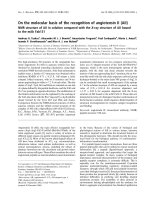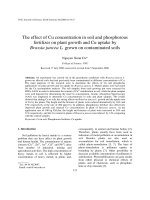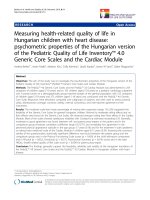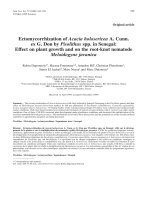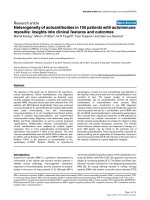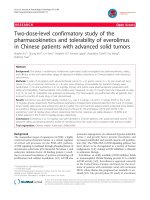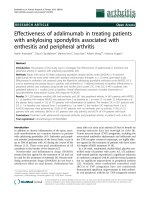Plant growth and yield response of tillage in wheat crop with rotavator and subsoiler combination and no tillage
Bạn đang xem bản rút gọn của tài liệu. Xem và tải ngay bản đầy đủ của tài liệu tại đây (235.12 KB, 4 trang )
Int.J.Curr.Microbiol.App.Sci (2018) 7(3): 1597-1600
International Journal of Current Microbiology and Applied Sciences
ISSN: 2319-7706 Volume 7 Number 03 (2018)
Journal homepage:
Original Research Article
/>
Plant Growth and Yield Response of Tillage in Wheat Crop with Rotavator
and Subsoiler Combination and No Tillage
Sushil Kumar*, Mukesh Jain, Vijaya Rani, Vinod Kumar, Anil Kumar and Naresh
Department of Farm Machinery and Power Engineering, CCS Haryana Agricultural
University, Hisar-125004, Haryana, India
*Corresponding author
ABSTRACT
Keywords
Tillage, No tillage,
Rotavator,
Subsoiler,
Compaction
Article Info
Accepted:
12 February 2018
Available Online:
10 March 2018
Following the industrial revolution in the nineteenth century, agricultural machinery and
tractors became available for tillage operations. Different types of tillage systems have
different tillage depths and capacity to change soil physical properties that affect the crop
yield and quality. Important soil physical properties such as bulk density, penetration
resistance, water infiltration, hydraulic conductivity and soil compaction are affected by
tillage. A study on the effect of various tillage methods on soil compaction was conducted
during Rabi season of 2013-14 at village Ladwa, Hisar, Haryana (India). Experiment
compared the yield, plant and soil parameters of no tillage and tillage with rotavator +
subsoiler. Higher soil resistance was found in zero tillage (T 1) as compared to treatment
rotavator + subsoiler (T 2). However, the soil resistance increased steadily after 30days
after sowing (DAS) and 90 DAS and it almost approached the initial soil resistance level,
as it was before tillage after 90 DAS. Higher infiltration rate was found in sub-soiler
treatment because of the obvious reason. Better plant establishment have been found in the
treatment where sub-soiler has been used due to better moisture availability, increased
water infiltration rate and increased root growth. Since, many soil parameters were in
favour of the treatment rotavator + sub-soiler (T2), significant increase in the yield was
also found in treatment rotavator + sub-soiler (T2).
Introduction
The prime necessity of tillage is to prepare the
land or the seedbed where the plants can easily
grow. Using different types of equipments
driven manually or by powered, machines
make the soil suitable to place the seeds into
the desirable depth. Tilling the fields hinders
or slowdown the growth of weeds and
improve crops’ competition against weeds.
Moreover, tillage loosens the compacted
layers. People started cultivation in the fertile
land close to the river valleys of Nile, Tigris,
Euphrates, Yangste and Indus. In the early age
it was not possible to till vast area of land to
desirable depth by hand tools. Following the
industrial revolution in the nineteenth century,
agricultural machinery and tractors became
available for tillage operations. Different types
of tillage systems have different tillage depths
and capacity to change soil physical and
chemical properties that affect the crop yield
and quality (Strudley et al., 2008). Time and
frequency of tillage also has significant effect
1597
Int.J.Curr.Microbiol.App.Sci (2018) 7(3): 1597-1600
on crop production (Stenberg et al., 1997).
Important soil physical properties such as bulk
density,
penetration
resistance,
water
infiltration, hydraulic conductivity and soil
compaction are affected by tillage (Hamza and
Anderson, 2005).
Materials and Methods
The study was carried out at farmer’s field at
village ladwa, Hisar, Haryana (India).
Experiment consisted of no tillage (T1) and
tillage operation with Rotavator + sub soiler
(T2). Soil parameters like soil resistance and
water infiltration rate were calculated.
Electronic cone penetrometer (model- 58020
Sensorika Australia) was used to measure soil
resistance.
Plant parameters like plant establishment, root
growth and yield parameter like no. of
grain/panicle, 1000-grain weight, and yield
were taken. Plant establishment was
determined after 15 and 30 days after sowing
(DAS) in both treatments. In each treatment,
numbers of plants were counted in an area of
one square meter.
Average root growth was determined in all the
treatments after 15, 30, and 45 days after
sowing. In each treatment, three plants were
detached carefully by digging instrument and
then the plant with the soil was washed with
water and the length of root was measured on
a scale.
Results and Discussion
The results of soil resistance (kPa) at different
depth (mm) of soil, before tillage, no tillage
and tillage with Rotavator + sub soiler is
graphically depicted in Figure 1. Soil
resistance in treatment T1 (no tillage) was
found similar to the soil resistance before any
tillage operation. However, significant
changes in soil resistance have been recorded
after using rotavator + sub soiler (T2), upto
250 mm. However, the soil resistance
approached the same level as it had been
before the tillage after the soil strata where the
implement cannot reach.
Kumar et al., (2012) also found higher soil
resistance in no tillage as compared to
conventional tillage. Elhers et al., (1983) also
concluded the similar values of soil resistance
for no tillage. Kishor et al., (2013) also
observed that most tillage practices have
pronounced effects on soil hydraulic
properties, infiltration rates, percolation,
leaching, and oxygen diffusion rate
immediately following non-tillage application,
but these effects can diminish rapidly.
Water infiltration rate as shown in the Table 1
was higher in treatment (T2) as compared to
treatment T1. Younesi Alamounti et al., (2007)
also found that water infiltration increased
with deep tillage.
In T1at 15 DAS, no. of plants/m2 area was 235
plants, and at 30 DAS it was 268 plants/m2
areas, and in T2 at 15 DAS, no. of plants/m2
area was 261 plants and at 30 DAS it was 275
plants/m2 areas. Higher plant population was
found in treatment T2 as shown in Table 2.
Chen et al., (2005) also found that sub soiling
promoted much faster crop emergence, higher
plant populations.
Higher root growth has been registered in
treatment T2 which was 86.7cm, 87.8 cm and
87.3 as compared to treatment T1 which was
86.5cm, 87.5 cm and 87 cm at respective
stages (15 DAS, 30 DAS AND 60 DAS) as
shown in Table 2. Hongguang et al., (2014)
also found similar results that subsoil tillage
promoted root development, increased nutrient
accumulation, and increased yield. Gajrai et
al., (2017) also found that soil related
constraints on root growth may be alleviated
through deep tillage.
1598
Int.J.Curr.Microbiol.App.Sci (2018) 7(3): 1597-1600
Table.1 Water infiltration rate (cm/minute) before and after tillage operation
Water Infiltration Rate (cm/minute)
Before
Treatment
1.13
No tillage (T1)
1.13
Rotavator + sub soiler (T2)
Treatment
No tillage (T1)
Rotavator +
sub soiler (T2)
After
1.19
2.67
Table.2 Plant Parameters at different stages after sowing
Plant parameters
Plant establishment
Root growth (cm)
At 15 DAS
At 30DAS
At 15 DAS
At 30 DAS
At 60 DAS
235
268
86.5
87.5
87
261
275
86.7
87.8
87.3
Table.3 Yield attributes of both treatments
Yield Attributes
No. of Grains/ Ear 1000 Grain Weight
Yield (q/ha)
Treatment
Head
(g)
60
38.90
58.87
No tillage (T1)
62
38.97
61.23
Rotavator + sub
soiler (T2)
Fig.1 Soil resistance (kPa) at different depth (mm) of soil before tillage, no tillage (T 1) and tillage
with rotavator + sub soiler (T2)
Maximum numbers of grains/ear-head were
found in treatment rotavator + sub-soiler (T2)
which was 62due to existence of favorable
conditions in this treatment. It was found that
maximum 1000 grain weight was in treatment
rotavator + sub-soiler (T2) because of maximum
favorable
conditions
such
as
higher
pulverization index, higher water infiltration
rate and higher root growth which resulted in
higher nutrient uptake (Table 3).
Maximum yield was found in treatment T2,
reason being comparatively higher root growth,
higher 1000 grain weight, higher plant
1599
Int.J.Curr.Microbiol.App.Sci (2018) 7(3): 1597-1600
population and also higher water infiltration due
to use of sub-soiler. Gangwar et al., (2004) also
found that among different tillage levels,
conventional tillage recorded the highest mean
yield of wheat.
The soil cone index varies with soil depth
profile. Lower soil CI values are associated with
a tilled layer near the soil surface, while higher
CI values are associated with a compact soil
layer below the tilled layer. The soil compaction
level almost approached the initial values as it
was before tillage operation after 90 days of
sowing. Higher water infiltration after deep
tillage. Tillage with rotavator and subsoiler
influence the root growth of wheat crop and
thus increases the root length. Significantly,
higher yield was produced using rotavator +
subsoiler as compared to no tillage.
References
Chen, Y., Cavers, C., Tessier, S., Monero, F.,
and Lobb, D. 2005. Short-term tillage
effects on soil cone index and plant
development in a poorly drained, heavy
clay soil. Soil & Tillage Research. 82:
161-171.
Ehlers, W., Kopke, U., Hesse, F., and Bohm,
W. 1983. Penetration resistance and root
growth of oats in tilled and untilled loess
soil. Soil & Tillage Research.3: 261-275.
Gajrai, P.R., Parihar, S.S., Cheema, H.S., and
Kapoor, A. 2017. Irrigation and tillage
effect on root development, water use and
yield of wheat on coarse textured soils.
Irrigation Science. 12(3): 161-168.
Gangwar, K.S., Singh, K.K. and Sharma, S.K.
2004. Effect of tillage on growth, yield
and uptake in heat after rice in the Indo-
Gangetic Plains of India. The Journal of
Agricultural Sciences. 142(4): 453-459
Hamza, M.A., and Anderson, W.K. 2005. Soil
compaction in cropping systems: A
review of the nature, causes and possible
solutions. Soil & Tillage Research. 82:
121-145.
Hongguang, Cai., Wei, Ma., Xiuzhi, Zhang.,
Jieqing, Ping., Xiaogong, Yan., Jianzhao,
Liu., Jingchao Yuan., Lichun, Wang., and
Jun, Ren. 2014. Effect of subsoil tillage
depth on nutrient accumulation, root
distribution, and grain yield in spring
maize. The Crop Journal. 2:297-307.
Kishor, P., Ghosh, A.K., and Claramma, P.V.
2013. Influence of tillage on soil physical
environment. International Journal of
Agronomy and plant production. 4(10):
2592-2597.
Kumar, A., Chen, Y., Sadek, A. and Rahman,
S., 2012. Soil cone index in relation to
soil texture, moisture content and bulk
density for no tillage and conventional
tillage. The CIGR Journal. 14(1): 26-37.
Stenberg, M., Aronsson, H., Linden, B.,
Rydberg, T., and Gustafson, A. 1997.
Nitrogen leaching in different tillage
systems. Proc. 14th ISTRO Conference,
27 July, 1 August, Puoawy, Poland,
Bibliotheca Fragmenta Agronomica.
2B/97: 605-608.
Strudley, M.W., and Green, T.R. 2008. Tillage
effect on soil hydraulic properties in
space and time: State of the science. Soil
and Tillage research. 99(1): 4-48.
Younesi, A.M., and Navabzadeh, M. 2007.
Investigation of plowing depth effect on
some soil physical properties. Pakistan
Journal of Biological Sciences. 10(24):
4510-4514.
How to cite this article:
Sushil Kumar, Mukesh Jain, Vijaya Rani, Vinod Kumar, Anil Kumar and Naresh. 2018. Plant
Growth and Yield Response of Tillage in Wheat Crop with Rotavator and Subsoiler Combination
and No Tillage. Int.J.Curr.Microbiol.App.Sci. 7(03): 1597-1600.
doi: />
1600
